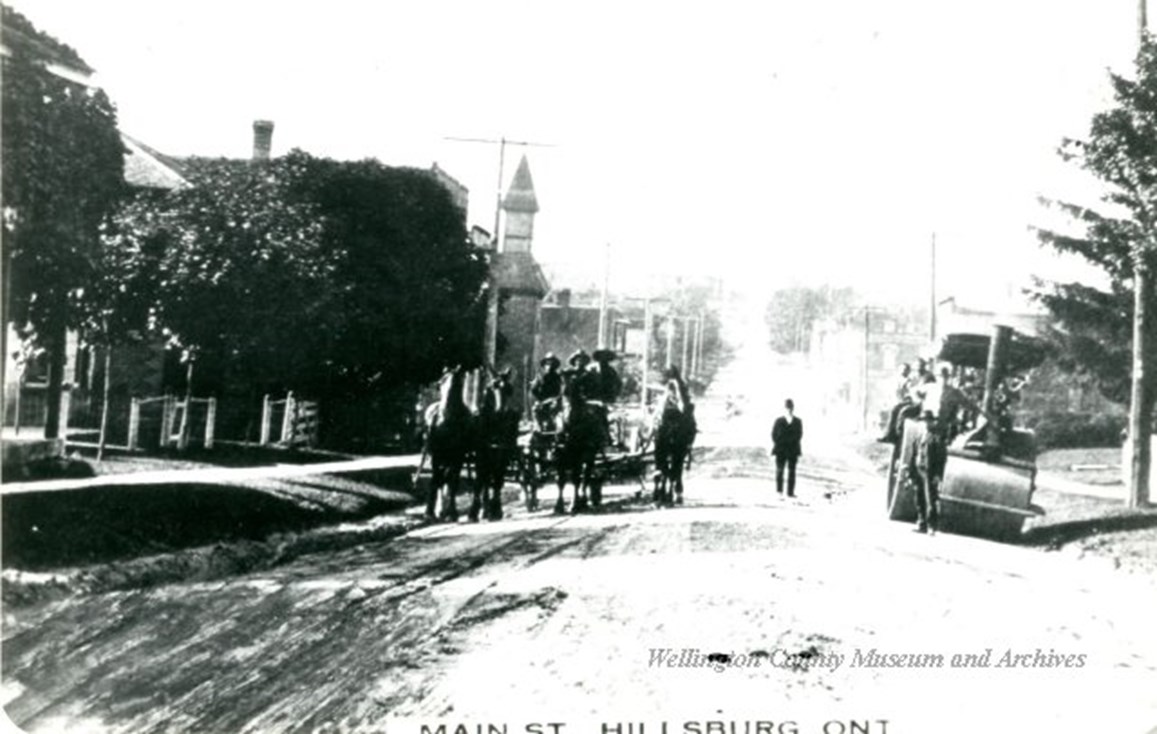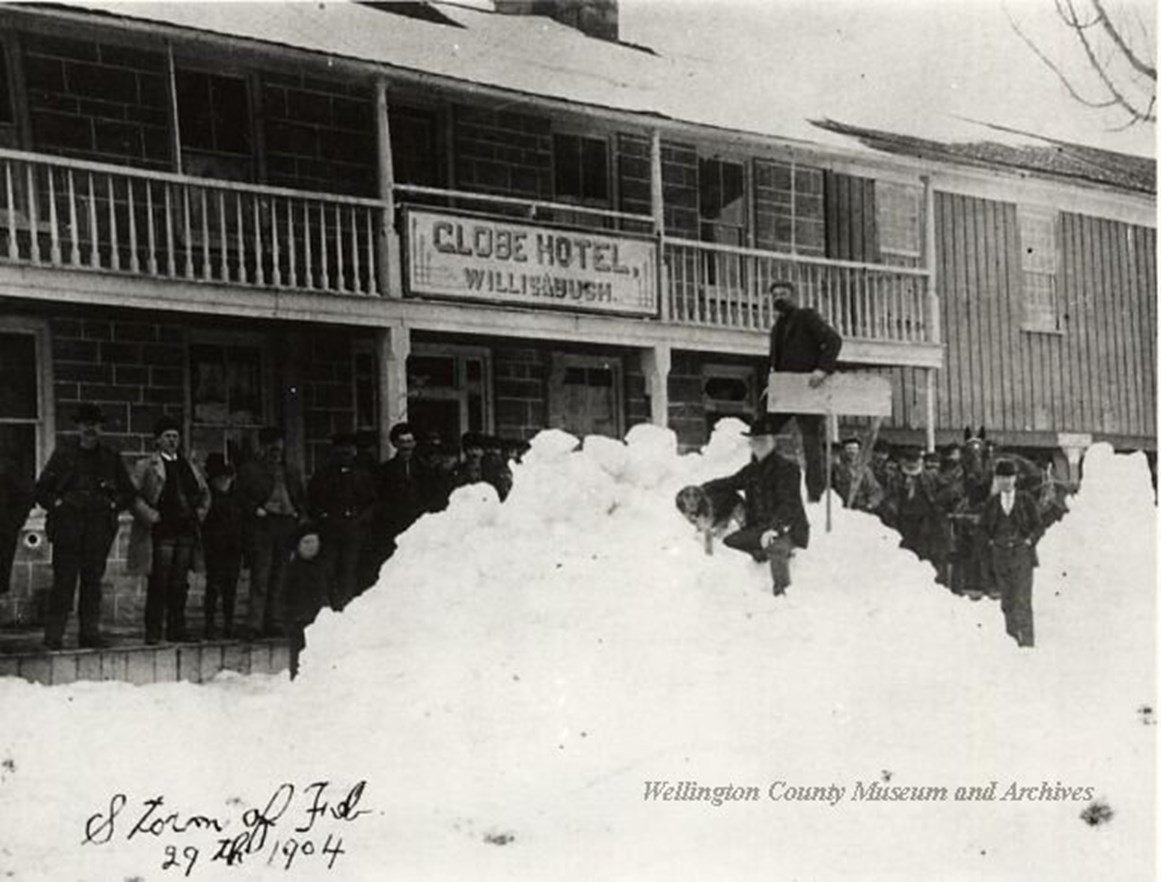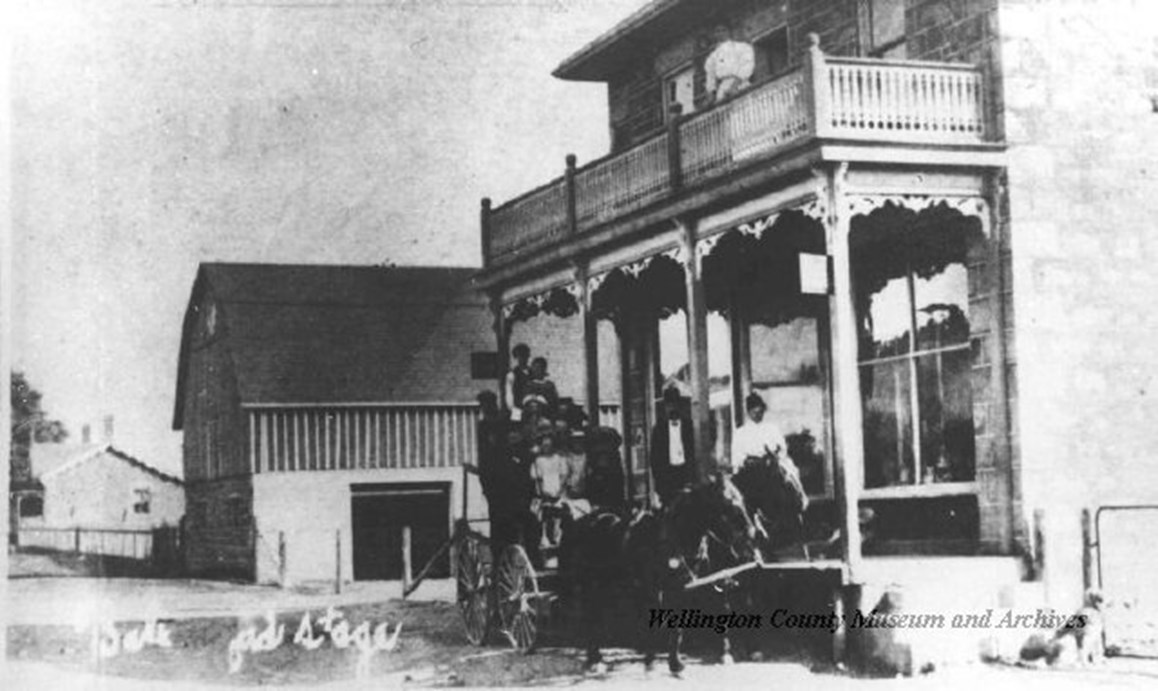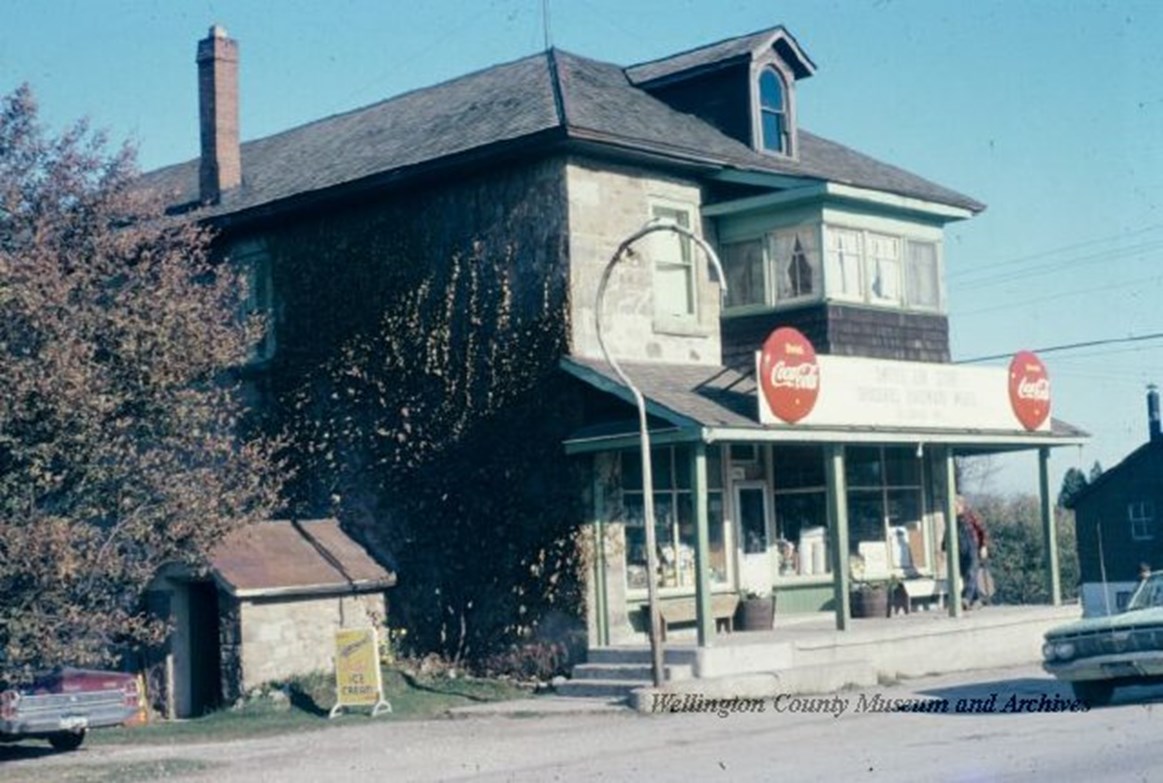EARLY ERIN: That drum roller seems almost too familiar. Here’s a photo from the Wellington County Museum and Archives of road work on Main Street in Hillsburgh from around 1921. Abraham Rodgers and William Cox are the teamsters in the photo, with road superintendent Joseph Benham in the centre. According to the Book Hillsburgh’s Heyday, by Patricia Kortland, Benham was the first road superintendent appointed to serve Erin Township in 1925 and was succeeded by Henry Wheeler, who served until 1970. Wellington County Museum and Archives photo
Here’s a photo from the Wellington County Museum and Archives showing snow piled in front of the Globe Hotel in Erin 120 years ago. This photo, included in Main Street: A Pictorial History of Erin Village, by Jean Denison, shows the front of the building after “the storm of 1904.”


Here’s a photo of the Ballinafad General Store from 1905 from the Wellington County Museum and Archives (#2807). Check out this second photo (#2567), taken 64 years later of the exact same store, which still stands today. Erin’s first settler arrived in Ballinafad in 1820, from Pennsylvania. The hamlet is named after a village in Ireland.

According to Steve Revell, author of A Brief History of Erin Village, this building was one of five mills built by Daniel McMillan, who is one of the founding fathers of Erin.
At just 18 years old, he bought the first sawmill in the area for $700, before erecting the first home in the village, an oat mill and more.
In 1849, he started work on this building, a grist mill, which was supposed to be the crowning glory of his career. Near the end of the construction, he got a splinter, which festered and turned gangrene.
McMillan, 38, died three days later and was buried in the Erin Pioneer Cemetery. The village, which was called McMillan’s Mills, was renamed Erinsville. This Mill was purchased by the County of Wellington in 2022 to become the Erin library branch, which is expected to open spring 2025. A Brief History of Erin Village was printed by Porcupine’s Quill in 2007, just steps from this very building.

Did you know that many of the villages and hamlets in Erin had different names over the years?
Orton used to be called Little Chicago, but was renamed to honour a beloved physician from Fergus who made trips out to care for the rural residents in the area. This photo is from the Wellington County Museum and archives (Photo number 5994) showing Orton’s Main Street in 1910.
Cedar Valley used to be Slabtown, honouring the Tarzwell family sawmill that ran in the area.
Brisbane was named Bristol, originally and the village of Erin was called McMillan’s Mills before being changed to Erinsville and later shortened to Erin.
Hillburgh’s name also has a storied past. The village was originally named Howville after William How, an early settler who ran a store in the village. He was blinded in one eye after a keg of gunpowder caught fire, blowing up the entire store. It was later renamed Hillsburg, after Nazareth Hill who built the first hotel. The ‘h’ was added on the end around 1899 when the area was incorporated into a police village.

Did you know that back in the early 1900’s, Erin was a destination for summer events?
The iconic Stanley Park was a hot spot for summer picnics, day trips, celebrations and multi-day concerts. Check out these advertisements in the Erin Advocate for “The Drummer’s Snack” on July 30, 1909. “To say that it was a complete success was to put it mildly,” read an article in the newspaper the week after the event.
It said that nearly 300 performers, family and members of the commercial traveler’s company came to town for the event. The hotels could not accommodate them all, and the Citizen’s Committee arranged for billets of private homes in town to accommodate them.
The article stated upwards of 2,500 people came out to the grand concert on Friday night. On Saturday there were musical acts and theatrical plays, followed by games including tug of war and broom hockey.
Stanley Park closed in the 1950’s, however, you can still see the arches that were the entrance to the Park along Main Street in Erin Village.

A series of Erin Advocate news articles from 1920 follow the push from residents and politicians to get hydro running through Hillsburgh.
On Jan 20, 1920 the Township of Erin authorized an agreement with the Cataract Electric Company LTD. and the Police Village of Hillsburgh to grant the company rights to occupy the highways to bring electricity to the village.
The agreement included a provision that the Cataract Electric Company provide 30 streetlights with 100-watt lamps, at $18 per light, per year for five years.
On May 26, Reeve James Milloy and members of the Community met with Premier Ernest Charles Drury to ask for the expedited approval of the contract.
One reverend said many residents had already wired their homes and installed poles in anticipation.
Drury gave them consent to continue with construction. The Cataract Electric company produced power from the Cataract Falls in Caledon, which was sold to Ontario Hydro in 1944 before its closure in 1947.
The above photo is of Hillsburgh seven years later, from the Wellington County Museum and Archives.

Erin Village was home to a famous Canadian Poet in the late 1800’s.
Alexander McLachlan moved to Canada from Scotland when he was 20, trying his hand at farming in Perth County and in Peel before opening a tailoring shop in Erin. As a father of 10 children, he struggled financially even though his poetry gained significant popularity and recognition.
He even became a lecturer for the government and an immigration officer for Scotland. He performed not only his own work for audiences, but also poems from Robert Burns, who he drew inspiration.
McLachlan wrote poems that honored his experiences and early life in Canada, he wrote about his love for the beauty of Elora, for the “trackless solitude” of the backwoods and even an ode to his friend Daniel McMillan after he died building the iconic McMillan Mill in Erin.
McLachlan eventually moved up to Dufferin County, farming in Amaranth before retiring to a house in Orangeville. He died in 1896.

Did you know that Wellington Road 124 used to be a toll road?
In the late 1800s the County of Wellington assumed the road from Brisbane to Guelph, upgrading it to gravel from corduroy.
“Toll gates were established at convenient distances along the way, there being no less than five between Hillsburgh and Guelph,” wrote C.J. McMillan, author of the Early History of the Township of Erin, published in 1921.
On the local streets and sideroads, residents had to do their part to keep these lines in working order, hitching up their carts to haul gravel and lay down new logs for corduroy.
According to Frank Freeman, an Erin resident interviewed in the book Older Voices Among Us: Listening to the long-time resident of Wellington County, residents were doing statute labour up until the 1920s.
“The amount you worked depended on your assessment and that’s the way the roads were kept up,” he said, recalling how he and his father worked on 5 Sideroad, which used to be grass and cedar corduroy. “In some places they took a pride in their road and did a good job and in others, well, it was just a holiday.”
This photo from the Wellington County Museum and Archives (#14873) shows an Erin stagecoach stopped in Ospringe in 1910.

Remembering our local veterans
Did you know that Erin has a long history of residents who have served in wars?
According to local Veteran and historian Doug Kirkwood, Author of “We Will Remember Them” The Men & Women of Erin & District, Erin’s military history goes as far back as Erin Township’s first settler. Nathaniel Roszel, who came from Pennsylvania, fought in the War of 1812 before settling in Ballinafad in 1820.
He and his brothers fought in the Battle of Queenston Heights and Lundy’s Lane.
Another early settler, Joseph Swackhamer, is said to have been an orderly for General Brock in the Battle of Queenston Heights. He settled on the outskirts of the Township.
Erin Village’s first physician, Dr. Henry McNaughton spent time in the Union Army as a surgeon during the American Civil War and is believed to have also served in the Franco-Prussian War.
During the First World War, several residents took up the call of King and Country, serving in battles overseas including Ypres, the Somme, Passchendaele and Cambrai.
Dave Mundell, who became the owner of the Mundel Lumber Company in Erin was a bank clerk before he enlisted and served with 124th Canadian Engineers in the battle for the Regina Trench, the first battle of the Somme in WW1.
Several Erin men were part of the battle of Vimy Ridge, including George Sutton, Clarence Spiers and James McCullough.
Erin residents, on two legs and four, also made considerable contributions to the Allied forces in the Second World War.
Oscar Steky, an Erin shoemaker and repairman, was the Erin Legion’s first president.
He joined the Lorne Scots Regiment and was sent to England to run an army boot manufacturing and repair shop. During his time there, he befriended a dog living in the camp, named Sport, who he trained to carry messages to other units. Sport became their mascot and came home with Steky to Erin in 1945.
Sport died in 1954 and was buried on the Erin Agricultural Society Grounds with full military honours.
These are just a handful of stories about the dedication and bravery of Erin Veterans. Copies of Kirkwood’s book are available at the Erin Legion for a $25 donation to the Poppy Trust Fund. Photos are courtesy of Doug Kirkwood.




What was Christmas like in Erin in the early 1900’s?
Christmas used to look a little different in Erin a century ago, but surprisingly, many things have stayed the same.
See this snowy photo of Downtown Erin Village from winter 1925? If you look closely at the right-hand corner, someone is hauling a Christmas tree.
Around this time, Christmas trees were decorated with real candles, and oranges were a special treat left in stockings.
Cards, stockings, and Christmas concerts were all staples of the season that remain popular today.
Christmas cards, like these collected by the Wellington County Museum and Archives, show well wishes from friends and family, as well as beautiful artwork.
One card, addressed to Ernie Awrey of Mimosa, from his cousin Hazel, shows a painting of Santa holding a stocking.

It says, “I must put something very nice into this; it belongs to Ernie Awrey.”
In his book, The Burt’s at Sunnyside, Clare Burt remembers his teacher Olive Awrey, coaching him for his part in the Christmas Concert held at Hillsburgh Town Hall. Burt said that the hall was packed for the show, where he and other Hillsburgh Public School students performed in the choir.
While the vehicles used to haul Christmas trees home, and the lights used to decorate them have changed. Many of the traditions associated with Christmas 100 years ago are still popular today.
 Skip to main content
Skip to main content